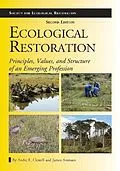Originally published in 2007, Ecological Restoration has become one of the seminal books in this quickly developing field. This completely revised and reorganized edition presents up-to-date developments and current trends in the field by two of its leaders. Among its key features are: Entirely new Virtual Field Trips, with additional examples woven into chapters Full treatment of the controversial topic of the restoration of semicultural ecosystems Up-to-date discussion of reference systems and reference models, which inform almost every aspect of restoration planning Full discussion of the global issue of ecosystem impairment and the complex topics of what restoration recovery means and how it is accomplished.
The authors focus on clarifying terminology, stressing the importance of precision in language for a field that is quickly becoming an established discipline. This new edition will be an invaluable resource for practitioners and theoreticians from a variety of backgrounds and perspectives, ranging from backyard volunteers to highly trained academic scientists and professional consultants.
Autorentext
Andre F. Clewell taught botany at Florida State University in Tallahassee for 16 years before entering private practice as a restoration practitioner and plant ecologist. He owned a consulting firm for 22 years. He served as President of the Society for Ecological Restoration and is currently the managing trustee of the newly formed nongovernmental organization, RNC-South Asia, which is affiliated with the RNC Alliance, based at the Missouri Botanical Garden. His research interests include ecosystem inventory and characterization, restoration ecology, and plant systematics. Clewell served on the board of directors of SER International during the first seven years of that organization's existence and as SER's second president for two of those years. He owned A.F. Clewell, Inc. in Holmes Beach, Florida, which was founded in 1984 and closed in 2006.
James Aronson is a full-time researcher, and for over 20 years has been involved with research and development programs aimed at restoring and rehabilitating degraded ecosystems in the Mediterranean region, South America, Africa, and elsewhere. Since 1992, he has been a researcher with the Center for Functional and Evolutionary Ecology (CNRS) in Montpellier, France, where he serves as Head of the Restoration Ecology Group. He is also Curator of Restoration Ecology at the Missouri Botanical Garden in St. Louis, Missouri.
Inhalt
About the society for ecological restoration
List of virtual field trips
Foreword; Paddy Woodworth
Preface
Part I. Why We Restore
Chapter 1. Overview
Some Basic Terms and Concepts
Chapter 2. Values and Ecological Restoration
Ecological Values
Personal Values
Socioeconomic Values
Cultural Values
Holons and Realms of Organization
Chapter 3. Disturbance and Impairment
Disturbance
Ecosystem Response to Disturbance
Degradation, Damage, Destruction
Ecological Consequences of Impairment
Part II. What We Restore
Chapter 4. Recovery
Ecological Views of Recovery
Ecological Theory and Restoration
Chapter 5. Ecological Attributes of Restored Ecosystems
Species Composition
Community Structure
Abiotic Environment
Landscape Context
Ecological Functionality
Historic Continuity
Ecological Complexity
Self-Organization
Resilience
Self-Sustainability
Biosphere Support
Goals and Project Standards
Chapter 6. Semicultural Landscapes and Ecosystems
Culturalization of Landscapes
Examples of Semicultural Landscapes
Selecting Semicultural Targets for Restoration
Part III. How We Restore
Chapter 7. Ecological References
Reference Concept
Types of Reference Sites
Steps in Reference Model Preparation
Temporal References
References in Landscape Restoration
Trajectories
Chapter 8. Approaches to Restoration
Intensity of Effort
Framework Approach
Sources of Knowledge
Chapter 9. Project Planning and Evaluation
Guidelines for Restoration
Strategies and Designs
Inoculating Soils and Substrates
Project Evaluation
Part IV. Ecological Restoration as a Profession
Chapter 10. Relationship of Restoration to Related Fields
Restoration Ecology and Ecological Restoration
Ecosystem Management
Rehabilitation, Reclamation, Revegetation, and Remediation
Compensatory Mitigation
Fabrication and Creation
Landscape Architecture and Design
Ecological Engineering
Restoration of Natural Capital
Sustainability Science
Chapter 11. Projects and the Professional
Stakeholders
Project Sponsors
Project Roles
Organizational Structure
Evolution of Contexts
Stewardship Models
Practitioner Certification
Chapter 12. Moving Restoration Forward-Together
Perceptions of Ecological Restoration
Novel Ecosystems
Climate Change
Moving Forward
Glossary
References cited
About the authors and collaborators
Index.
